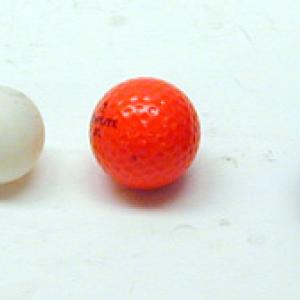College of Liberal Arts & Sciences
1N30.21 - Elastic & Inelastic Collision of Solids - Balls
The happy/sad ball set has one ball that bounces much like a super ball and one ball that bounces very little.
Combinations of the other balls will give different elastic coefficients.
- Jorge Sztrajman and Alejandro Sztrajman, "An Easy Way to One-Dimensional Elastic Collisions", TPT, Vol. 55, #3, Mar. 2017, p. 164.
- David Kagan, "Demonstration of the 'Trampoline Effect' In Aluminum Bats", TPT, Vol. 49, #6, Sept. 2011, p. 398.
- Joshua Gates, "A Teachable Moment Uncovered by Video Analysis", TPT, Vol. 284, #5, May 2011, p. 284.
- Norman Derby and Robert Fuller, "Reality and Theory in a Collision", TPT, Vol. 37, #1, Jan. 1999, p. 24.
- Herman Erlichson, "Newton's Strange Collisions", TPT, Vol. 33, #3, Mar. 1995, p. 169.
- Gareth J. Lewis, J. Cris Arnold, and Iwan W. Griffiths, "The Dynamic Behavior of Squash Balls", AJP, Vol. 79, #3, Mar. 2011, p. 291.
- Rod Cross, "Differences Between Bouncing Balls, Springs, and Rods", AJP, Vol. 76, #10, Oct. 2008, p. 908.
- Robert Ehrlich, "5.6, Inelastic Collisions Usings 'Newton's Cradle'", Why Toast Lands Jelly-Side Down, p. 91.
- Robert Ehrlich, "E.1. Inelastic Collision Between Two Balls", Turning the World Inside Out and 174 Other Simple Physics Demonstrations, p. 51.
- Janice VanCleave, "Determine the Effect of Temperature on How High a Rubber Ball Bounces", Super Science Challenges, p. 125.
Disclaimer: These demonstrations are provided only for illustrative use by persons affiliated with The University of Iowa and only under the direction of a trained instructor or physicist. The University of Iowa is not responsible for demonstrations performed by those using their own equipment or who choose to use this reference material for their own purpose. The demonstrations included here are within the public domain and can be found in materials contained in libraries, bookstores, and through electronic sources. Performing all or any portion of any of these demonstrations, with or without revisions not depicted here entails inherent risks. These risks include, without limitation, bodily injury (and possibly death), including risks to health that may be temporary or permanent and that may exacerbate a pre-existing medical condition; and property loss or damage. Anyone performing any part of these demonstrations, even with revisions, knowingly and voluntarily assumes all risks associated with them.
